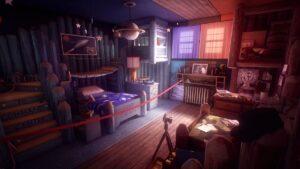The game I played for this week’s critical play is What Remains of Edith Finch. The game is developed by Giant Sparrow and directed by Ian Dallas. I played the game on PC (Steam), but it is also available on other platforms including PlayStation, Switch, iOS, Xbox. The target audience of this game are players who enjoy slower-paced games with deep narratives.
What Remains of Edith Finch makes use of walking to tell the story of the Finch family. In the game, the player controls Edith as she explores her abandoned family home, uncovering the tragic history of the family along the way. There are two distinct styles of walking within the game, one where the player wander through the many rooms of the Finch family home, and one where players walk through the stories of each family member before they meet their tragic ends. These two styles of walking complement each other to create a powerful video game narrative experience.
Walking within the Finch house as Edith, the game makes great use of the detailed environment to create the narrative. Every room in the house is filled to the brim with objects and memorabilia left by the people who once lived there. These rooms tell the story of each family member. As players explore the rooms and inspect these objects, they get a real sense of who each person is, their lives, interests, and aspirations.

Walking within the Finch house also creates the strong aesthetic of discovery. Unlike many other walking sims, this game takes place almost entirely indoors, meaning that the amount of distance walked is actually quite small. Despite this, the environment feels memorable and full of personality. Edith walks at a slow pace, so players are forced to slow down and look at all the things around them. The intricate layout of the house, with a basement leading down to a cave and rooms extending upwards into the trees, along with the various hidden doors and secret passageways that the player has to navigate through, creates the aesthetic of discovery and keeps walking fun. It evokes the sense that the player is slowing unveiling a mystery.
The walking I enjoyed the most was not just exploring the house, but also the varied stories of each member of the family. These stories are told in different ways that are unique to each character. Barbara’s story is told through a horror comic book, Gregory’s story is told from his fantastical perspective of the world as a baby playing with toys in the bathtub, Sam’s story is told through the photos he and his daughter takes on a hunting trip. Walking through these stories allows the players to experience the lives of these characters from their eyes before their deaths, complementing the exploration of their rooms to paint a full picture of who each person is. My favorite story is Lewis’, where we start off with simulating his rote work at the cannery chopping off fish heads, then wander into the magical kingdom within his mind. These sequences are beautifully constructed, they evoke a stark contrast between the colorful and wondrous worlds that each character sees against the inevitable tragedy of their death. Edith writes at the end of the game to her newborn son, “I don’t want you to be sad that I’m gone. I want you to be amazed that any of us ever had a chance to be here at all.” These sequences allow the players to appreciate that despite the backdrop of tragedy and the generally ominous atmosphere of the game, the lives of the people who lived there do not have to be seen as such. In fact, these stories themselves are rarely bleak, instead they are often full of life, filled with the aspirations, joy and hope that each character embodies.

Finally, walking in this game is complemented with narration, either from Edith or the different family members. Every line narrated appears as physical words within the environment. This is not only a brilliant way to do subtitles, but also serves as a guide for the players as they navigate the space, as the words appear in directions that the game wants the player to turn their attention to. Despite the complexity of the house layout, I was never lost and always knew where I should go next (in other games of this type there are always moments when I’m not sure how to progress the story and have to backtrack a bunch). Narration in this game guides the player along the path of the story. Walking in this game is almost like turning pages of a book, except the narrative is delivered in a way that is far more evocative and immersive than what could be done in a purely text-based format.
What Remains of Edith Finch is one of the most beautiful games I’ve played. I’ve heard about this game over the years, so I’m happy to have an excuse to finally play this game.




